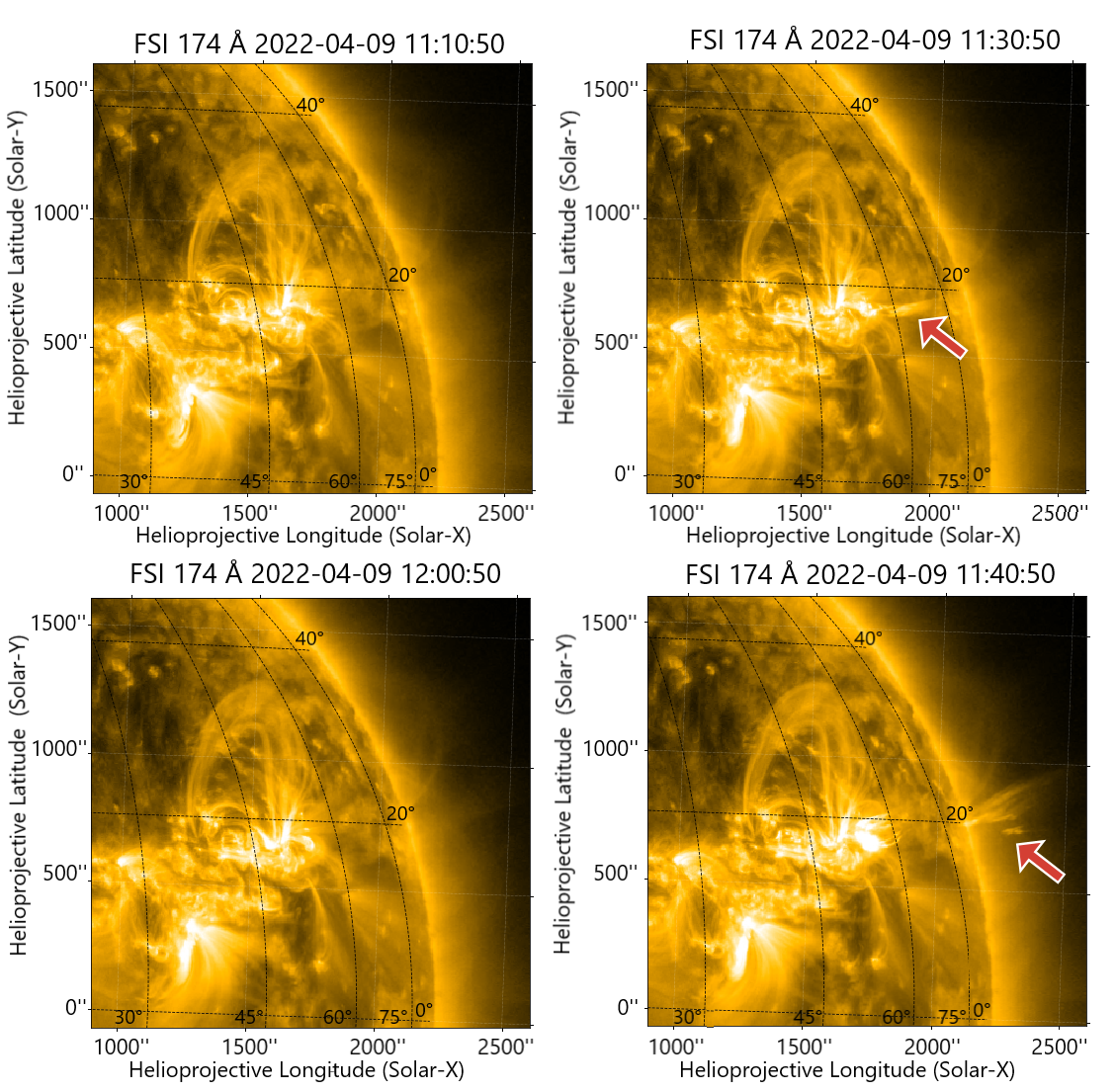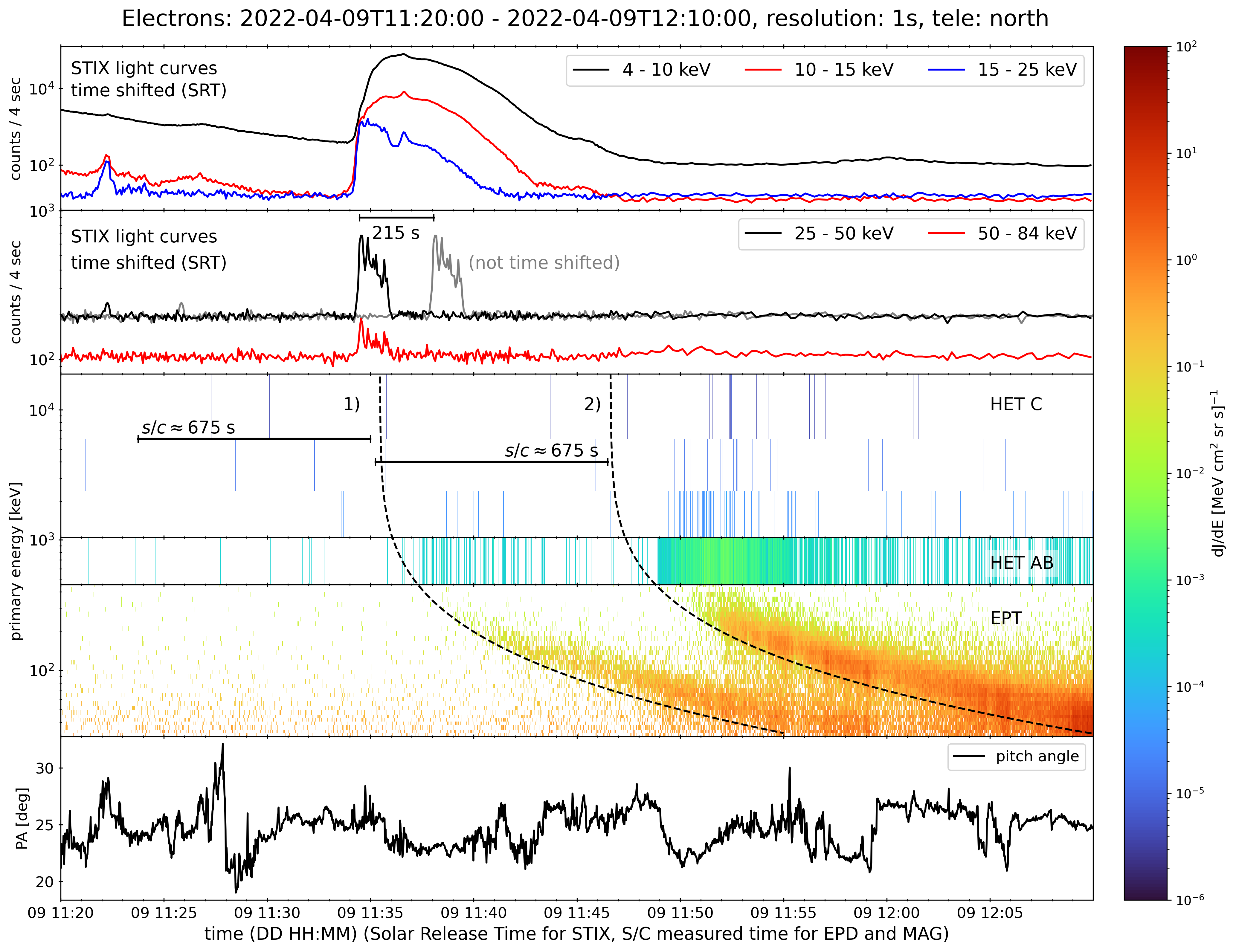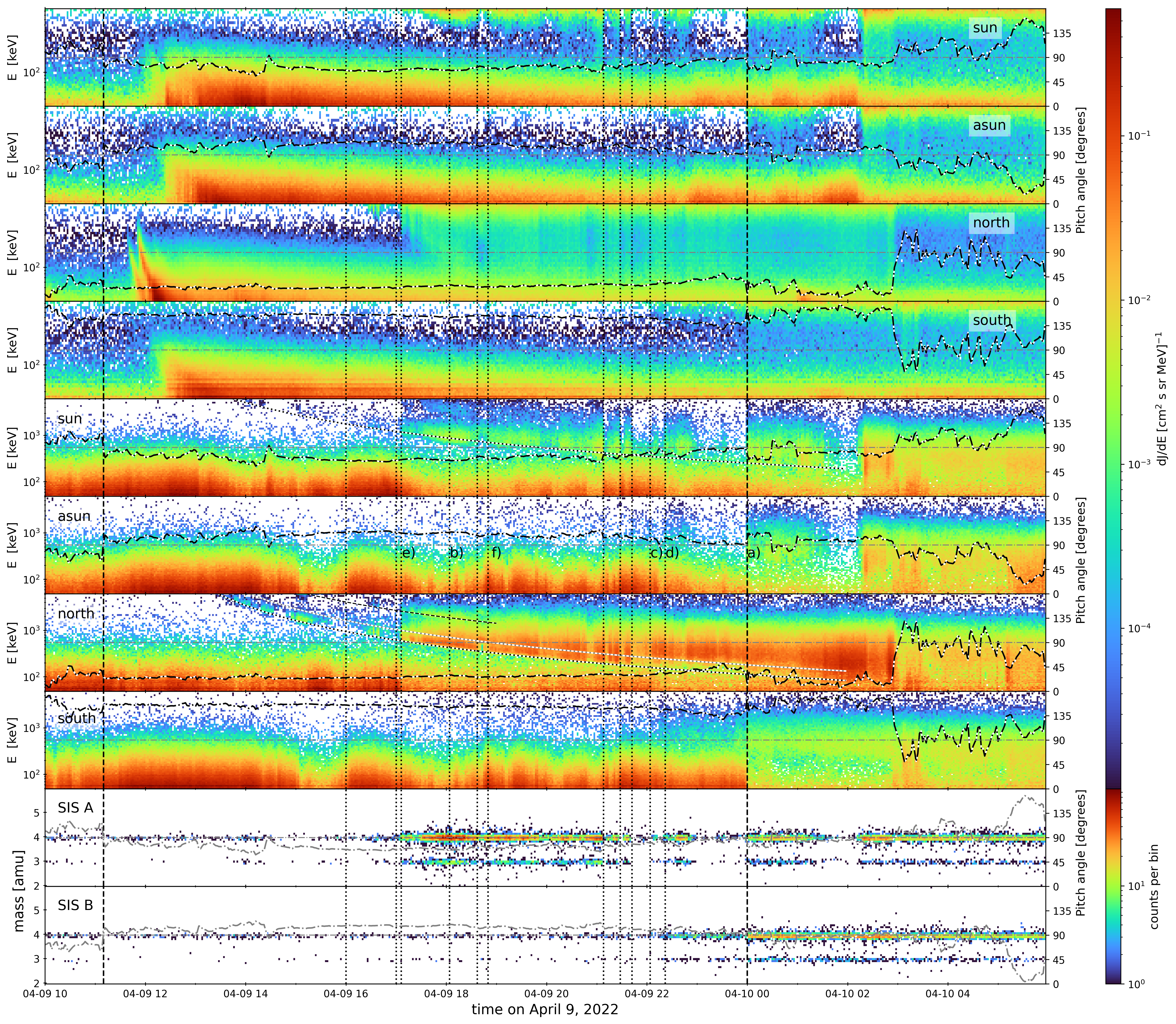Science nugget: Unusually long path length for a nearly scatter-free solar particle event observed by Solar Orbiter at 0.43 au - Solar Orbiter
Unusually long path length for a nearly scatter-free solar particle event observed by Solar Orbiter at 0.43 au
(Solar Orbiter nugget #17 by R.F. Wimmer-Schweingruber1, L. Berger1, A. Kollhoff1, P. Kühl1, B. Heber1, et al.)
On the 9th of April 2022 Solar Orbiter observed a virtually scatter-free solar particle event with an unusually long magnetic connection while immersed in a magnetic cloud. It was observed both in energetic electrons and ions while Solar Orbiter was at 0.43 au from the Sun. The length of the magnetic field line was inferred to be about three times longer by analyzing the velocity dispersion of electrons and ions.
Introduction
Solar particle events originate in association with solar flares and/or coronal shocks driven by coronal mass ejections (CMEs). A spacecraft that is magnetically well connected to the acceleration region will first register the fastest escaping particles, and then increasingly slower ones. By measuring the arrival times and speeds of the registered particles one can thus determine both the onset time of the particle event as well as the path length along which the particles traveled.
On the 9th of April 2022, the Energetic Particle Detector (EPD, [1]) on Solar Orbiter detected electrons and ions which showed clear velocity dispersion. Remote-sensing observations showed that they were released from the same solar source region in the western limb region of the Sun; the source event was observed by the Spectrometer/ Telescope for Imaging X-rays (STIX, [2]), as well as the Extreme Ultraviolet Imager (EUI; [3]), see Fig. 1. Using data from EPD, the magnetometer (MAG, [4]) and the Electrostatic Analyser System (EAS) of the Solar Wind Analyzer (SWA; [5]), Wimmer-Schweingruber et al. determined that the energetic electrons and ions traveled along an unusually long magnetic field line. While Solar Orbiter was located at 0.43 astronomical units form the Sun, they inferred a path length s ≈ 1.35 au or longer.

Figure 1. EUI Observations of the source region of the 9th April 2022 solar particle event show a small jet indicated by a red arrow.
Analysis
Energetic electrons measured by EPD show two injections, as can be seen in Fig. 2. The two electron events show clear velocity dispersion with higher energy electrons arriving before electrons with lower energy. X-ray observations shown in the top two panels have been time-shifted (by 215 s) for the light travel time from Sun to Solar Orbiter, the gray curve in the second panel from the top illustrates an un-shifted time profile. Horizontal bars indicated by s/c = 675 s in the third panel show the inferred travel time to Solar Orbiter of highly relativistic (v ≈ c) electrons released at the Sun. Their left-hand ends thus indicate the solar release times of highly relativistic electrons. The first event is delayed by approximately three minutes with respect to the small peak in low-energy (10 – 15 and 15 – 25 keV) X-rays, as would be expected based on previous studies [6, 7, 8]. The second event, however, appears to coincide with increased X-ray emission at 25 – 50 and 50 – 84 keV. This remarkable observation was very likely only made possible by the small variability of the interplanetary magnetic field (IMF), as seen in the bottom panel of Fig. 2 which illustrates the low level of fluctuations. The variance of the 1s-averaged pitch angle during this time period is 2.8 degrees while EPT’s half opening angle is 15 degrees. Inferred onset times and path lengths are given in Table 1.
|
Injection |
Onset time |
Inferred path length |
|
Electron 1 |
11:25:14 ± 00:33 |
1.231 ± 0.038 au |
|
Electron 2 |
11:34:29 ± 00:28 |
1.456 ± 0.028 au |
|
Proton 1 |
11:45:16 ± 02:58 |
1.374 ± 0.011 au |
|
Proton 2 |
12:06:53 ± 05:16 |
1.678 ± 0.021 au |
Table 1: Inferred onset times and path lengths of the two electron and ion events observed by Solar Orbiter EPD on 9thApril 2022.

Figure 2. STIX light curves (top two panels) and EPD measurements of energetic electrons agree remarkably well when allowing for a travel path length of 1.35 au.
Solar Orbiter remained magnetically connected to the solar source region for many more hours and so EPD also observed the ions accelerated by this solar eruption, as can be seen in Fig. 3 which shows EPD’s electron and ion observations for all four telescopes. The two electron injections discussed above are clearly seen in EPD’s north telescope while the other telescopes measure elevated electron intensities later than the north telescope. Similarly, the north ion telescope sees two ion injections. It is obvious that the ion event is confined to the north-pointing telescope (as was the electron event) with a very weak counterpart in the sunward-pointing telescope. The dash-dotted lines in all panels of Fig. 3 show the central pitch angle of the various telescopes. Comparison of ion intensities in EPD’s north- and sunward-pointing telescopes shows that the particle beam had a 1/e-width of approximately 30 degrees which is comparable to the full opening angle of one of EPD’s EPT telescopes. The solar release times inferred from velocity dispersion analysis of the ions are also reported in Tab. 1 and are only slightly delayed with respect to the electrons.

Figure 3. EPD observations in the sun, anti-sun, north and south telescopes of electrons (top 4 panels) and ions (next 4 panels) during the 9 April 2022 particle event. The bottom two panels show EPD/SIS measurements of the helium isotopes in the sunward/anti-sunward directions
Interpretation & Conclusions
The solar electron and ion events reported here are unusual not only because of their long magnetic connection back to the Sun, but also because the timing of these two homologous pairs of (electron and ion) events appear to agree so well with the X-ray observations. Typically, ions are expected to be accelerated higher up in the corona than the electrons which results in a delay in the ion onsets [9]. The 9 April 2022 event discussed in this paper, however, shows a reasonable agreement with the timing of the X-ray flares for electrons and a shorter delay for ions than usual, and very similar path lengths for electrons and ions. While the ions are injected after the electrons in this event, their time lag is small compared to the Krucker & Lin (2000) results, especially if the ions were accelerated in conjunction with the second, larger, and more energetic flare or electron acceleration event.
Remarkably, the IMF pointed in the negative N direction (in Radial, Tangential, Normal (RTN) coordinates) throughout the event, an unusual orientation, and thus particles were observed primarily by the EPT north telescope. This unusual orientation, likely due to Solar Orbiter being immersed inside an ICME flux rope, provided the unusually long path length along which the particles traveled. The low level of fluctuations in the IMF throughout this time period resulted in less scattering than is usually observed and thus maintained the strongly focused electron and ion beams. Together, these observations provide strong limitations on the properties of energetic particle transport inside an ICME (and the associated flux rope).
This work has been published in: Wimmer-Schweingruber et al., 2023, A&A, https://doi.org/10.1051/0004-6361/202346319
Affiliations
1 Institute of Experimental and Applied Physics, Christian-Albrechts-University Kiel, Leibnizstraße 11, 24118 Kiel, Germany
References:
[1] Rodríguez-Pacheco, J., Wimmer-Schweingruber, R. F., Mason, G. M., et al. 2020, A&A, 642, A7
[2] Krucker, S., Hurford, G. J., Grimm, O., et al. 2020, A&A, 642, A15
[3] Rochus, P., Auchère, F., Berghmans, D., et al. 2020, A&A, 642, A8
[4] Horbury, T. S., O’Brien, H., Carrasco Blazquez, I., et al. 2020, A&A, 642, A9
[5] Owen, C. J., Bruno, R., Livi, S., et al. 2020, A&A, 642, A16
[6] Krucker, S., Larson, D. E., Lin, R. P., & Thompson, B. J. 1999, ApJ, 519, 864
[7] Haggerty, D. K., & Roelof, E. C. 2002, ApJ, 579, 841
[8] Simnett, G. M., Roelof, E. C., & Haggerty, D. K. 2002, ApJ, 579, 854
[9] Krucker, S., & Lin, R. P. 2000, ApJ, 542, L61
- Removed a total of (26) style text-align:left;
- Removed a total of (22) style border:none;
- Removed a total of (2) style margin:0;
Nuggets archive
2025
09/04/2025: Bursty acceleration and 3D trajectories of electrons in a solar flare
02/04/2025: Picoflare jets in the coronal holes and their link to the solar wind
19/03/2025: Radial dependence of solar energetic particle peak fluxes and fluences
12/03/2025: Analysis of solar eruptions deflecting in the low corona
05/03/2025: Propagation of particles inside a magnetic cloud: Solar Orbiter insights
19/02/2025: Rotation motions and signatures of the Alfvén waves in a fan-spine topology
12/02/2025: 'Sun'day everyday: 2 years of Solar Orbiter science nuggets that shed light on some of our star's mysteries
22/01/2025: Velocity field in the solar granulation from two-vantage points
15/01/2025: First joint X-ray solar microflare observations with NuSTAR and Solar Orbiter/STIX
2024
18/12/2024: Shocks in tandem : Solar Orbiter observes a fully formed forward-reverse shock pair in the inner heliosphere
11/12/2024: High-energy insights from an escaping coronal mass ejection
04/12/2024: Investigation of Venus plasma tail using the Solar Orbiter, Parker Solar Probe and Bepi Colombo flybys
27/11/2024: Testing the Flux Expansion Factor – Solar Wind Speed Relation with Solar Orbiter data
20/11/2024:The role of small scale EUV brightenings in the quiet Sun coronal heating
13/11/2024: Improved Insights from the Suprathermal Ion Spectrograph on Solar Orbiter
30/10/2024: Temporally resolved Type III solar radio bursts in the frequency range 3-13 MHz
23/10/2024: Resolving proton and alpha beams for improved understanding of plasma kinetics: SWA-PAS observations
25/09/2024: All microflares that accelerate electrons to high-energies are rooted in sunspots
25/09/2024: Connecting Solar Orbiter and L1 measurements of mesoscale solar wind structures to their coronal source using the Adapt-WSA model
18/09/2024: Modelling the global structure of a coronal mass ejection observed by Solar Orbiter and Parker Solar Probe
28/08/2024: Coordinated observations with the Swedish 1m Solar Telescope and Solar Orbiter
21/08/2024: Multi-source connectivity drives heliospheric solar wind variability
14/08/2024: Composition Mosaics from March 2022
19/06/2024: Coordinated Coronal and Heliospheric Observations During the 2024 Total Solar Eclipse
22/05/2024: Real time space weather prediction with Solar Orbiter
15/05/2024: Hard X ray and microwave pulsations: a signature of the flare energy release process
01/02/2024: Relativistic electrons accelerated by an interplanetary shock wave
11/01/2024: Modelling Two Consecutive Energetic Storm Particle Events observed by Solar Orbiter
2023
14/12/2023: Understanding STIX hard X-ray source motions using field extrapolations
16/11/2023: EUI data reveal a "steady" mode of coronal heating
09/11/2023: A new solution to the ambiguity problem
02/11/2023: Solar Orbiter and Parker Solar Probe jointly take a step forward in understanding coronal heating
25/10/2023: Observations of mini coronal dimmings caused by small-scale eruptions in the quiet Sun
18/10/2023: Fleeting small-scale surface magnetic fields build the quiet-Sun corona
27/09/2023: Solar Orbiter reveals non-field-aligned solar wind proton beams and its role in wave growth activities
20/09/2023: Polarisation of decayless kink oscillations of solar coronal loops
23/08/2023: A sharp EUI and SPICE look into the EUV variability and fine-scale structure associated with coronal rain
02/08/2023: Solar Flare Hard Xrays from the anchor points of an eruptive filament
28/06/2023: 3He-rich solar energetic particle events observed close to the Sun on Solar Orbiter
14/06/2023: Observational Evidence of S-web Source of Slow Solar Wind
31/05/2023: An interesting interplanetary shock
24/05/2023: High-resolution imaging of coronal mass ejections from SoloHI
17/05/2023: Direct assessment of far-side helioseismology using SO/PHI magnetograms
10/05/2023: Measuring the nascent solar wind outflow velocities via the doppler dimming technique
26/04/2023: Imaging and spectroscopic observations of EUV brightenings using SPICE and EUI on board Solar Orbiter
19/04/2023: Hot X-ray onset observations in solar flares with Solar Orbiter/STIX
12/04/2023: Multi-scale structure and composition of ICME prominence material from the Solar Wind Analyser suite
22/03/2023: Langmuir waves associated with magnetic holes in the solar wind
15/03/2023: Radial dependence of the peak intensity of solar energetic electron events in the inner heliosphere
08/03/2023: New insights about EUV brightenings in the quiet sun corona from the Extreme Ultraviolet Imager








































 Sign in
Sign in
 Science & Technology
Science & Technology